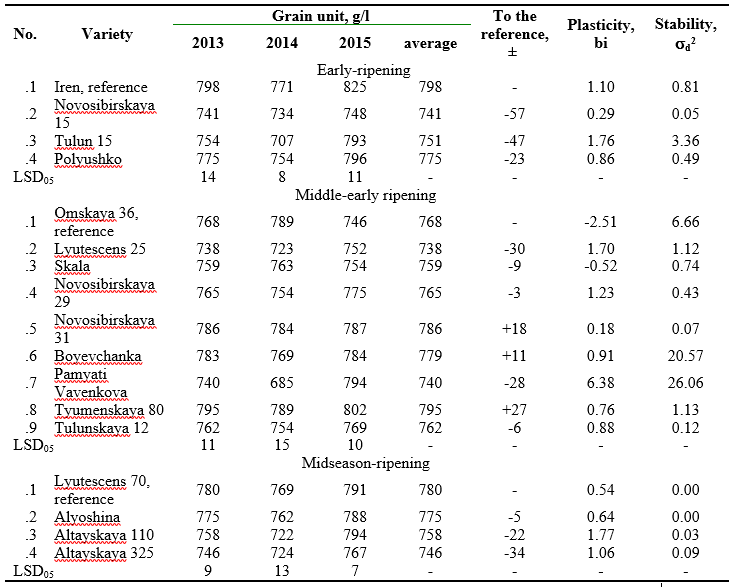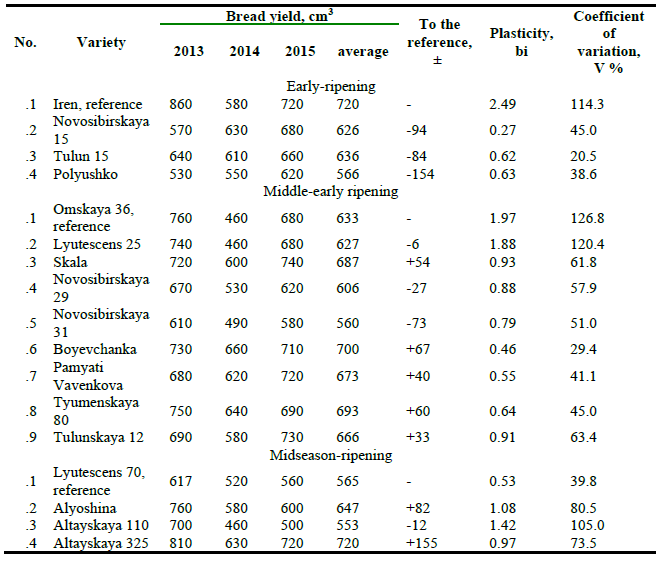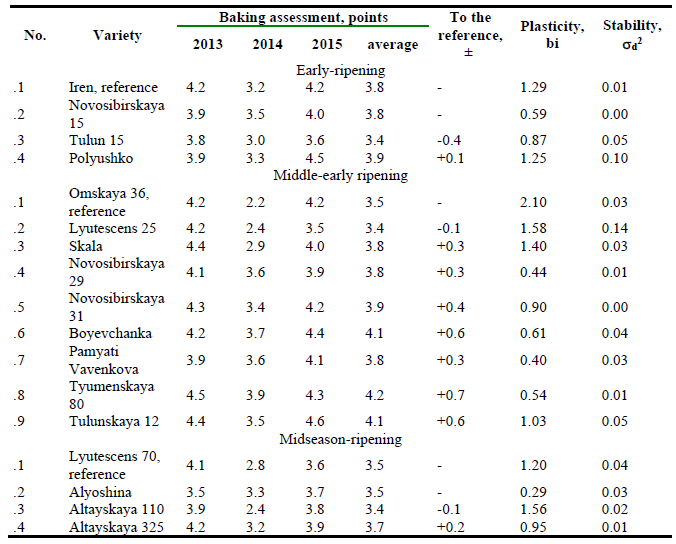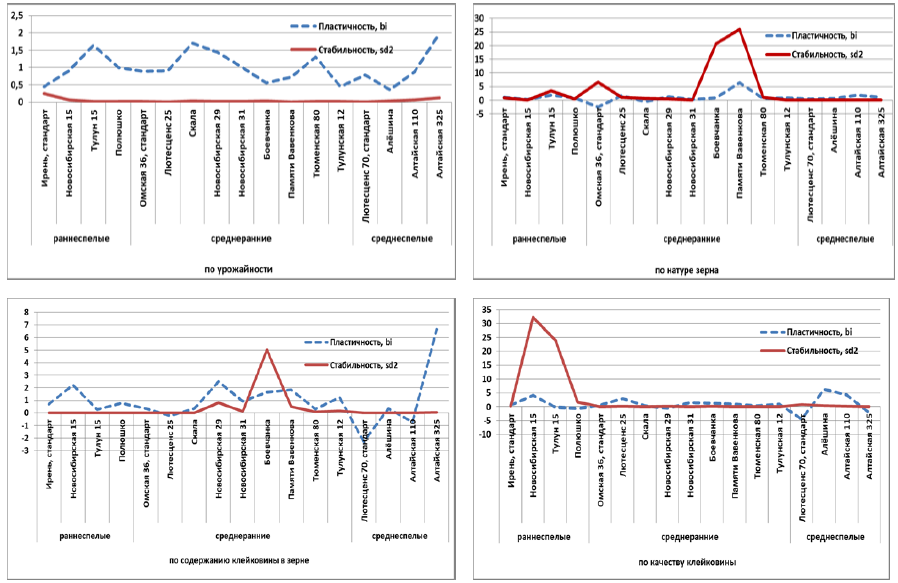The yield and baking quality of Siberia-bred spring soft wheat varieties in the north forest-steppe of the Tyumen region
ABSTRACT
Over the past century and at the beginning of the current one, Siberian breeders have been intensively breeding spring soft wheat for improving the yield and grain quality. The ecologically and geographically diverse source material has been used at the breeding and educational institutions of the region. Thus, in the severe Siberian conditions, the wheat gene pool has been painstakingly created. It has been very difficult here to solve the problem of improving the grain quality, but, given the determination and the talent of many breeders and geneticists, the gene pool of valuable and strong wheat varieties has been created. As a result, being formerly a consumer of food wheat, Siberia has now become a region producing high-quality grain for domestic use and sale in the foreign market. The gene pool of spring soft wheat, which is so rich in the volume and quality, has not been studied in full, and not used throughout Siberia. In 2013 – 2015, sixteen valuable and strong varieties of Siberia-bred wheat had been studied in the northern zone of the Tyumen region on the experimental field of the Northern Trans-Ural State Agricultural University. It has been found that the average productivity of the early-ripening Novosibirskaya 16, Tulun 15, and Polyushko varieties over the three years amounted to 2.52 – 2.89 t/ha, and was close to the yield (2.35 – 3.10 t/ha) of the middle-early ripening varieties. In the midseason-ripening group, the Alyoshina and Altayskaya 110 and 325 varieties exceeded the Tyumen-bred standard Lutescens 70 by 0.23 – 0.69 t/ha with the yield of the latter being 2.54 t/ha. In terms of the content and quality of gluten, the following varieties stood out: Iren, Novosibirskaya 15, Tulun 15, Polyushko, Omskaya 36, Skala, Boyevchanka, Pamyati Vavenkova, Tyumenskaya 80, Alyoshina, and Altayskaya 325. In terms of baking properties (3.7 – 4.2 points), the following varieties stood out: Iren, Novosibirskaya 15, 29, 31, Polyushko, Skala, Boyevchanka, Pamyati Vavenkova, Tyumenskaya 80, Tulunskaya 12, and Altayskaya 325, which can be used as the source material for further wheat breeding.
keyword
spring soft wheat, source material, variety, yield, grain quality
Introduction
Over the past decades, the progress of spring wheat breeding in Siberia has been quite obvious. The created varieties in many economic respects, including grain quality, have an obvious advantage over the old ones (Anosov et al., 2015; Golikova, 2018; Zakshevskaya et al., 2016; Likhenko, 2007; Garkovenko et al., 2018; Kazak & Loginov, 2019).
Grain quality is monitored genetically, but it is highly dependent on the weather conditions. Therefore, in breeding new varieties, Siberian breeders have to overcome great difficulties. Nevertheless, valuable and strong wheat varieties have been bred in such extreme conditions of the region, and every fifth loaf of bread in the country is baked from the grain of these varieties (Kazak & Loginov, 2016; Likhenko et al., 2018; Lapochkina et al., 2017; Likhenko et al., 2015).
The Tyumen region is located in the northern agricultural zone of Siberia (Ageeva et al., 2015; Ageeva & Likhenko, 2017; Iglovikov, 2016). It is even more difficult to produce wheat with high baking properties here (Belkina & Letyago, 2017a; Belkina & Letyago, 2017b; Loginov et al., 2016). In the past, many valuable and strong varieties of spring soft wheat bred in other regions had formed low grain quality, and only in the 70 – 80ies of the twentieth century, with the creation of the strong Tyumenskaya 80 variety in the local conditions, the problem of grain quality was successfully resolved. This variety was well adapted to the conditions of the Tyumen region and steadily formed high baking properties over the years (Moiseeva, 2017a; Loginov et al., 2018).
Literature review
The total area of the Tyumen region is 1,435,200 km². The agricultural zone of the Tyumen region is located in the south and makes up 3% of the total area. The wheat sowing area in the Tyumen region is 410 thous. ha. The average yield in the region is 23.3 t/ha. 58% of the total sown area is occupied by spring soft wheat and only 1/3 of the wheat produced has high baking qualities (Likhenko, 2007; Zakshevskaya, Kuksin, Zagaytov, 2016).
Breeding wheat varieties with high grain quality depends on the availability of the source material and the state of knowledge (Guseynov, 2015; Kazak et al., 2015; Loginov, Kazak, Filatova, 2016). The valuable and strong Siberian-bred wheat varieties in this respect are a reliable foundation for further wheat breeding in the region (Tabolova, 2015; Gadimaliyeva et al., 2018; Shamanin et al., 2017).
The research was aimed at studying the valuable and strong Siberian-bred wheat varieties in the northern forest-steppe zone of the Tyumen region and at choosing the valuable sources in terms of the yield and grain quality for breeding programs.
Location and methods
The studies were performed in 2013 – 2015 in the northern forest-steppe of the Tyumen region on the experimental field of the Northern Trans-Ural State Agricultural University. The soil was leached black soil (Eremin, 2016), with heavy loamy particle size distribution, with the humus content of 7.2 %, medium content of phosphorus and nitrogen, high content of potassium, and the soil solution reaction of -6.7 (Eremin, 2017; Shakhova et al., 2017; Eremin & Eremina, 2016). The predecessors were annual herbs (peas + oats). The technology used was the one generally adopted for the crop in the area (Abramov et al., 2015; Kazak et al., 2019). Sowing was preformed using a SSFK-7 nursery planter at the optimum time. The plot area was 30 m2, the accounting area was 25 m2; the experiment was repeated four times on randomly located plots. The references were the early-ripening Iren variety, the middle-early ripening Omskaya 36 variety, and the midseason-ripening Lyutescens 70 variety. The observations and surveys were performed following the method of State Grade Testing for crops (Metodika Gosudarstvennogo sortoispytaniya selskokhozyaistvennykh kultur, 1997).
The content and quality of gluten were assessed according to GOST 27839-2013 by washing weighed portions of 25 g under running water and using an IDK instrument, ecological plasticity and adaptability were studied following the guidelines of S.A. Eberhart and W.A. Rassel in the presentation of V. A. Zykin (Zykin et al., 2011). The guidelines allow determining both the plasticity and stability of the samples, as well as calculating the linear regression coefficient (bi), which characterizes the ecological plasticity of the variety, and the mean square deviation from the regression line (σd2), which determines the stability of the variety under various environmental conditions. Harvesting was performed using a Sampo 130 combine harvester, the yield data were processed following the statistical method of B. A. Dospekhov (Dospekhov, 1985). The grain yield was taken into account separately after threshing with a Sampo 130 combine harvester. The threshed grain was placed in bags with labels, and the samples were taken in sealed containers to determine the harvesting moisture content of the grain. The weight of grain from the plots was counted in t/ha and brought to 100% purity and 14% moisture. General baking assessment was determined in a grain quality laboratory. Grain unit was measured using grain-unit scale. Flour strength was determined on the farinograph. The bread volume was measured using the trial baking.
Results and discussion
The yield is one of the main parameters of a wheat variety. At the beginning of the past century, local varieties Sibirka uluchshennaya, Krasnokoloska, etc. gave a yield of 0.7 – 1.2 t/ha (V. V. Burlaka, 1975). The average wheat yield in the former Tobolsk Governorate was 0.5 – 0.7 t/ha. Over more than 100 years, the average yield of spring wheat in the Tyumen region has increased to 2.4 t/ha; however, in the expiring year 2018, it was 2.1 t/ha. The dynamics are positive, but productivity still grows slowly.
So far, the Zavodoukovsk district has reached the level of sustainable wheat productivity of 3 t/ha. The Uporovo and the Tyumen districts are close to it. For many districts in the region, the noted result remains fantastic so far.
As for the wheat varieties, local breeders and breeders from other districts have created high-yielding Ikar, Tyumenskaya yubileynaya, Iren, Omskaya 36, Novosibirskaya 31, etc. varieties, which provide the yield of 5 – 6 t/ha or more at the Ishim and Nizhnyaya Tavda State Crop Testing sites. Unfortunately, most farms in the region commercialize their potential productivity by only 30 – 40 %.
Table 1. The yield of the valuable and strong Siberian spring soft wheat varieties in the northern forest-steppe zone of the Tyumen region, 2013 – 2015.

The valuable and strong Siberian wheat varieties studied in the experiment (Table 1) formed the yield of 2.27 – 4.13 t/ha. Low yields were observed in 2013 for all studied wheat varieties, especially Novosibirskaya 15 and Lutescens 70, which amounted to 2.27 t/ha. Nevertheless, the Iren, Tulun 15, Omskaya 36, and Tyumenskaya 80 varieties with a yield of 2.76 – 3.50 t/ha stood out that year.
On average over the three years of the study, the Iren, Omskaya 36, Tyumenskaya 80, and Altayskaya 325 varieties stood out in terms of the yield (3.09 – 3.23 t/ha).
Table 2. Grain unit of the wheat varieties, 2013 – 2015.

In the market conditions, the yield of wheat varieties should match grain quality, which the sales price and the economic state of the crop in production depend on. Grain quality is a comprehensive indicator. It includes many parameters, including the grain unit (Table 2). The yield of flour after milling depends on the grain unit. Over the years of the study, high grain unit was observed in the Iren, Polyushko, Skala, Novosibirskaya 31, Boyevchanka, Tyumenskaya 80, Tulunskaya 12, Lyutescens 70, and Alyoshina varieties. The grain unit of these varieties was 759 – 798 g/l, i.e., they met the requirements for strong wheat. Low grain unit (738 – 746 g/l) was noted in the Lutescens 25, 15 Novosibirskaya, and Altayskaya 325 varieties.
Among the grain quality parameters, the content and the quality of gluten are of great importance. Gluten contains proteins, which are insoluble in water (glutenins and gliadins). The content and quality of gluten in the grain of wheat varieties are genetically monitored, but their manifestations largely depend on the environmental conditions (Belkina & Letyago, 2017c; Isupova et al., 1999; Letyago, 2013; Moiseeva, 2017b; Yakubyshina et al., 2018).
Table 3. The gluten content in the grain of the Siberia-bred spring wheat varieties, 2013 – 2015.

The studied wheat varieties were different from each other in terms of the gluten content and quality (Tables 3 and 4). For instance, in 2013, the gluten content varied from 30.0 % in the Lutescens 25 and Skala varieties to 37.7 % in the Altayskaya 110 variety; in 2015, it varied from 30.9 % in the Skala variety to 42.3 % in the Novosibirskaya 15 variety. In both observed years, the studied valuable and strong Siberia-bred wheat varieties accumulated 30 % or more
of gluten in the grain. In 2014, the Novosibirskaya 15 and Novosibirskaya 29 varieties accumulated 23.3 % and 24.4 % of gluten, respectively, while the other varieties showed higher content. In whole over the three years of the studies, wheat varieties accumulated gluten at the level of the requirements for strong and valuable wheat, which once again showed the success of Siberian breeding for improving wheat grain quality.
Table 4. The gluten quality of the Siberia-bred spring wheat varieties, 2013 – 2015.

Gluten of the first quality group was formed in all the years of the study in the following varieties: Novosibirskaya 15, Tulun 15, Polyushko, Omskaya 36, Skala, Boyevchanka, Pamyati Vavenkova, Tyumenskaya 80, Alyoshina, and Altayskaya 325. These varieties are the valuable source material for further wheat breeding in the region.
For the baking industry, along with the grain quality, the strength of the flour, the bread yield, and the overall baking properties are of particular importance. The high-quality wheat varieties should have the flour strength not less than 280 alveograph units (a.u.). The strength of the flour determines the volume and the porosity of bread. Table 5 shows flour strength properties.
Table 5. The strength of the flour obtained from the spring wheat varieties, 2013 – 2015.

On average over the three years, the flour strength of the studied wheat varieties was 377 – 825 a.u. In the context of the years of the research, not a single variety showed the flour strength below 280 a.u., which means that all varieties met the requirements for strong wheat. The maximum flour strength was noted in the Alyoshina (1,061 a.u.) variety in 2013 and the Altayskaya 110 and Omskaya 36 varieties (1,000 – 1,067 a.u.) in 2015.
Table 6. The bread yield from 100 g of the flour obtained from the Siberia-bred spring wheat varieties, 2013 – 2015.

The bread yield without special additives varied from 460 cm3 for the Omskaya 36 and Lutescens 25 varieties in 2014 to 860 cm3 in the Iren variety in 2013 (Table 6). Over the years of the research, the following varieties were the best: Iren, Tulun 15, Skala, Boyevchanka, Pamyati Vavenkova, Tyumenskaya 80, and Altayskaya 325.
The analyzed and other values of the baking assessment should be balanced between themselves, thereby ensuring a high value of the bread. The standard of the high baking qualities may be the formerly cultivated domestic wheat varieties — Cesium 111, Saratovskaya 29, Zarnitsa, Tulunskaya 197, and foreign varieties, such as Marquis, Garnet, Manitoba, and others. Closer to the modern period of wheat breeding development in Siberia, the Tyumenskaya 80, Irtyshanka 10, Tulunskaya 12, Pamyati Aziyeva, Novosibirskaya 15, 29, and 31, Pamyati Vavenkova, Altayskaya 70, and other varieties were created, which were not inferior to their predecessors in terms of baking assessment.
Table 7. General baking assessment of the Siberia-bred spring soft wheat varieties in the northern forest-steppe zone of the Tyumen region, 2013 – 2015.

Analyzing the data about the general baking assessment of the studied wheat varieties (Table 7), it should be noted that it depended on the variety and the weather conditions during a particular year. In 2014, the baking assessment of all the tested varieties was lower, compared to 2013 and 2015, to a lesser extent for some varieties (Novosibirskaya 15, Polyushko, Novosibirskaya 29, Boyevchanka, Pamyati Vavenkovaa, Tyumenskaya 80, Tulunskaya 12), and to a greater extent for other varieties (Omskaya 36, Lutescens 25, Altayskaya 110).
On average over the years of the research, in terms of the baking assessment (3.7 – 4.2 points), the following varieties stood out: Iren, Novosibirskaya 15, 29, and 31, Polyushko, Skala, Boyevchanka, Pamyati Vavenkova, Tyumenskaya 80, Tulunskaya 12, and Altayskaya 325.
Table 8. The coefficient of correlation between the grain yield and quality indices, 2013 – 2015.

In choosing the source material for further wheat breeding in the Tyumen region, it is important to know the correlation between the yield and grain quality (Table 8). It was found that the relation between the grain yield and the grain unit in the early-ripening and the middle-early ripening varieties was close positive, while in the midseason-ripening varieties, it reduced to 3.7. A similar pattern was observed in terms of the flour strength, the bread yield, and the general baking assessment. Between the yield and the gluten content in the grain, the relation was negative from weak to medium.
The plasticity and stability of the formation of the varieties productivity and the quality indicators are shown in Figure 1.

Figure 1. The plasticity and stability of valuable and strong Siberia-bred spring wheat varieties in the northern forest-steppe zone of the Tyumen region, 2013 – 2015.
The calculations of stability and plasticity following the method of S. A. Eberhart and W.A. Rassel show that the yield over the years of the research was formed consistently in all varieties. Novosibirskaya 15 and Polyushko varieties in the early-ripening group, the standard Omskaya 36, Lutescens 25, and Novosibirskaya 31 varieties in the middle-early ripening group, and Altayskaya 110 in the midseason-ripening group featured plasticity.
In terms of grain quality, including the formation of the grain unit, almost all of the studied varieties formed the grain unit inconsistently, especially varieties such as Omskaya 36, Boyevchanka and Pamyati Vavenkova. In terms of the gluten content, the most interesting varieties as the most stable gluten accumulating ones over the years of the study were the early-ripening Novosibirskaya 15 and Polyushko varieties, and the middle-early ripening Novosibirskaya 29 and 31, and Tulunskaya 12 varieties. In terms of the gluten quality, intensive varieties Novosibirskaya 15, Alyoshina, and Altayskaya 110 stood out.
Conclusions
The study of the valuable and strong wheat varieties of Siberian selection in the northern forest-steppe of the Tyumen region has identified the following valuable sources: Iren, Novosibirskaya 15; 29; 31, Polyushko, Skala, Boyevchanka, Pamyati Vavenkova, Tyumenskaya 80, Tulunskaya 12, Altayskaya 325, which can be used as starting material for further breeding, as valuable sources for yield and grain quality.
Studying the valuable and strong Siberia-bred varieties of spring soft wheat in the northern forest-steppe of the Tyumen region has shown that in terms of many economic properties, they are well adapted to the local conditions. With that, they have both quite acceptable productivity and high grain quality.
The allocated sources are included in the program on the development of promising new varieties of spring soft wheat under the study of high-yielding varieties creation for baking in Siberia.

